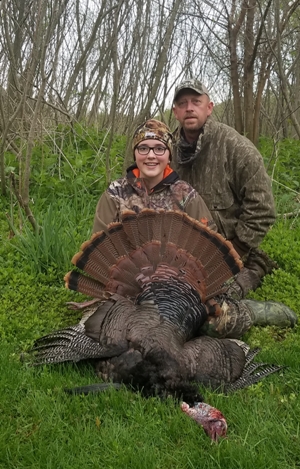 I hunted one tom hard during our second season and finally gave up on him. Then I hunted him for 10 days during the last season before I was able to take him. This ole gobbler was the big dog on campus. I think he had all the hens as a part of his harem from across much of the area. In the mornings, when I tried to hunt him, he always would have at least a minimum of 12 hens with him.
I hunted one tom hard during our second season and finally gave up on him. Then I hunted him for 10 days during the last season before I was able to take him. This ole gobbler was the big dog on campus. I think he had all the hens as a part of his harem from across much of the area. In the mornings, when I tried to hunt him, he always would have at least a minimum of 12 hens with him.
During that last season, when all of his hens were on the nest, I went up to the ridge where he had been roosting all season long. I moved much closer to him than I had in the past, and he pitched down off the roost into a little flat on the ridge. I had gotten to that flat well before daylight. When that old tom saw my hen decoys and realized that they were the only girls in town, he came right to them. I had a really good feeling when I squeezed the trigger on that ole gobbler, and he flopped over. Describing that feeling is hard. But when you’ve put in as much time as I’ve spent trying to take that turkey, and you finally tag him, there’s a tremendous relief that you’ve finally done it, followed by the joy and excitement that comes when you know that you’ve outsmarted one of the smartest birds in the woods. I was as proud of that gobbler as I would have been if I had taken a Boone & Crockett buck during deer season. When you put a lot of time and effort into trying to take one particular gobbler and finally succeed, you get a really good feeling that is hard to describe. I am often asked what I named that turkey. I explain we usually don’t name turkeys in our section of Iowa, because there are so many up here to hunt.
However, the turkey we are hunting right now in turkey season, 2017, we’ve given him a name. We call him the Butterball Turkey because with the season being three weeks old and getting several good looks at that tom, I know that this Butterball Turkey should weigh about 30 pounds. He looks huge, when I am able to see him walking around, but he’s the only turkey I ever have named. This ole gobbler is staying with a bunch of other gobblers. Although the other gobblers will come to a turkey call, Butterball won’t respond to a call. Also, Butterball has seen a couple of his buddies bite the dust, and the more exposure he has to hunters, the tougher he’ll be to take. He is also shying away from the decoys. Butterball probably thinks if a hen sees him and doesn’t come to him, there must be something wrong with that hen. I think the only way I’m going to take this turkey is if he survives to the end of this season when all the hens are on the nest. Then I may be able to call him in close enough to take. I’ll try and get close enough to him when he is on the roost to put my decoys out, and they will be the only hens he sees that morning. Then maybe he will come in and present the shot.
Day 1: Iowa Turkeys Are So Big




























